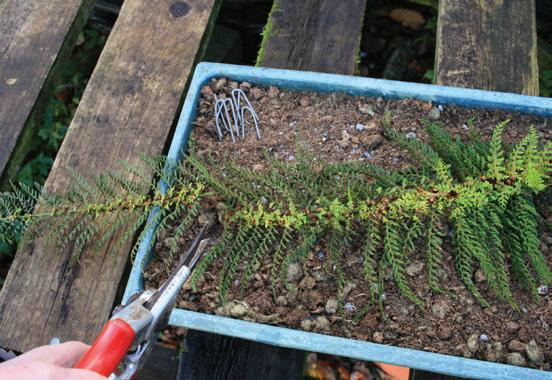
4 minute read
Gardening/Home & Garden
Time to call in a garden designer?
By Sally Gregson
AT this season, and especially last year, we have looked at our gardens struggling through the long drought, now under snow and ice, and perhaps thought of at least one or two modifications, or downright changes, we could make.
Full of plans and promises, we vow to improve the garden this winter. But, of course, it rains at last – the ice melts and the frost evaporates, along with our good intentions, and another year passes. It could be time to employ the services of a garden designer.
A good designer will soon save you money spent on inappropriate plants and expensive constructions, and will sit down and talk with you about your concerns and planting tastes. He, or she, will analyse the soil; the aspect of the garden; and how much sun there is through the year. They will consider the proximity of neighbours, roads and eyesores.
And then they will go away and think of solutions to any perceived problems and run them past you before putting pen to paper, or fingers to keyboards.
Once the designer has drawn up a draft plan, including the location of any existing garden buildings – sheds, greenhouses, a detached garage – and located any planned additions, you, and he or she, will be ready for the pretty bits.
It’s here that their knowledge and expertise can also save time and money. They will make lists of favourite and suitable plants, including trees, shrubs and perennials that will make the garden your own.
Quite often a local garden designer has a favourite nursery where they will buy on a regular basis and can charge you less than the usual price. Buying multiple plants often carries a discount for quantity. A knowledgeable designer can recommend a suitable nursery or nurseries that can supply the majority of necessary plants.
The ’dead’ days of January are just the time to enlist an expert’s help. They are less busy – everyone thinks about their gardens in spring when there is already too much to think about and do. So, decide just how much you want to spend and get an estimate of costs. And set the ball rolling. It will soon be spring!
A garden designer’s knowledge and expertise can save time and money PHOTO: eleus500/Pixabay
Spring green for the winter garden
EX-DISPLAY SHEDS, Stables/field shelters, summerhouses, offices, workshops, agricultural 01935 891195
GUTTERS CLEARED
• Windows, • Fascias, • Soffits, • Gutters cleaned, • Repairs, • Free Estimates 07788-376752
Garden Design
£395
Est 20 Years
By Sally Gregson
IN winter gardeners tend to rely on evergreens and the occasional spark of flower to give their gardens interest and pizazz.
And those evergreens do tend to be quite dark-leaved. Hollies, ivies, laurels all seem to have shining, deep green leaves. It’s the fresh green that is often missing.
Hardy, ‘evergreen’ ferns are mostly just that – light, refreshing, spring green. They survive the harshest of winters tucked up in the shade of shrubs and roses, out of the sun’s cold glare, clothing the bare legs of deciduous shrubs and roses with lacy green petticoats.
Our native Hart’s Tongue ferns are ideal for popping in difficult, dry, shady spots. And there are lots of variations with interesting leaves. Some are bifurcated, that is their tips are divided; some have serrated edges to their fronds; while in others the whole leaf margin undulates.
A planting of these Adiantum scolopendrium ‘Undulatum’ covering the ground beneath winter-flowering shrubs, such as Viburnum x bodnantense ‘Dawn’, for example, looks like a stormy coastline with rough green waves.
Then there are the dozens of varieties of Polystichum with its upright, laddered fronds. Some, such as P. setiferum ‘Divisilobum’ grows to about 60cm and, like the Hart’s Tongues, is tolerant of dry shade.
But P. setiferum has a useful trick up its frond – it makes little fernlets all along the leaf at each axil. In December and January it is possible to cut off a frond displaying the fernlets, and pin it down on a tray of cuttings compost – 50:50 compost and grit – to make more of itself. The fernlets should have rooted, or not, by the spring, when each can be given a separate pot and grown on until big enough to plant out the following year.
At the end of the winter, as spring starts to prompt new growth everywhere, the ‘evergreen’ ferns take a month off. Their over-wintered foliage goes brown and dies back before their new croziers start to unfurl. A wise gardener will cut back the tired old leaves at this stage, to allow the young growth room to expand. And then the croziers will magically unfurl into fronds, to start another year in a shady part of your garden.

Cut off a frond of P. setiferum, displaying the fernlets, and pin it down on a tray of cuttings compost to make more of itself










